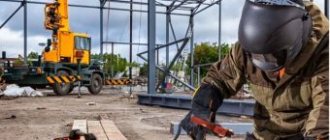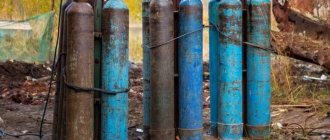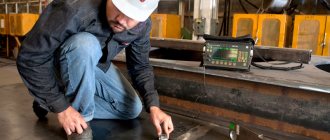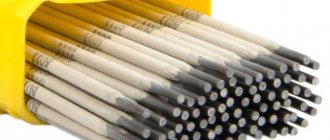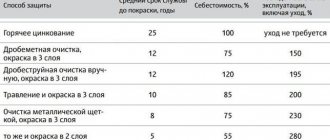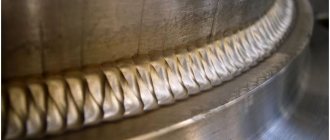Home / Consumables
Back
Reading time: 4 min
0
1263
The manufacture and installation of various metal structures is not complete without the use of electric arc welding. The process is approved by some GOSTs and SNiPs, depending on the nature of the work performed.
Incoming control or verification of the quality of welding materials is determined by their routine inspection, verification of actual certificates for the newly purchased batch.
These are electrodes, tapes, cored and solid wires, rods, fluxes, and protective regulated gases.
The former are used to supply high-frequency current to the workpiece, while the welding wire is a filler material that fills the area between the workpieces. The composition of the latter must correspond to the material of the structures being connected.
Fluxes dissolve oxides on a metal surface, which improves the wetting of parts with molten metal and prevents oxidation by limiting the access of oxygen.
Welding threads and rods act as filler substances. Shielding gases prevent the entry of the surrounding atmosphere into the weld pool.
- Material control
- Electrodes
- For stainless steels
- Fluxes
- Shielding gases
- Wire
- Flaw detection
Material control
All welding elements and materials supplied to the enterprise must be supplied with certificates that stipulate the data of GOSTs, SNiPs, technical factors and passports.
Packaging boxes, crates, packs and pressure containers must have tags or labels indicating the passport information of the welding material.
Failure to comply with this condition does not allow the use of a specialized substance for the work, which is the reason for a complete check of the welding material in all quality parameters. They must correspond to the given type of welding elements.
Electrodes
The compliance of the electrodes with the passport data is checked at the manufacturer and before carrying out work at the production site or construction site. Inspection of rods made of electrically conductive material begins with an external inspection.
From each batch, 10-20 welding units or 0.5% of the batch are selected for quality control. If testing reveals an increased number of electrodes with a flaw, the entire group is rejected.
The mechanical properties of electrically conductive rods with a diameter of up to 3.0 mm are checked by bending them and dropping them onto a steel plane from a height of 100 cm; if the thickness of the electrode exceeds the specified size, the height is halved.
The quality control rules for welding materials provide for partial spalling of the coating, but its total length should not exceed 20 mm, which is stipulated by State Standard 9466-60.
The technical conditions also allow for minor defects in the area of the rods:
- some roughness of the coating, insignificant longitudinal notches, burrs that have a depth not exceeding a quarter of the coating;
- no more than three local depressions per half the thickness of the lining, no longer than 1.2 cm each;
- voids - up to 3 by 10 cm in length, and their diameter should be less than 2.0 mm, no more than half the depth of the layer;
- no more than 2 hairline cracks, each up to 1.2 cm long.
The homogenized mass—coating—must be applied concentrically relative to the rod. Its compliance is checked over the entire section by making cuts and measuring the thickness of the coating.
The thickness difference cannot exceed the following indicator:
electrode Ø 2.0 mm - 0.080 mm;
- 2,50 — 0,10;
- 3,0 — 0,150;
- 4,0 — 0,20;
- 5,0 — 0,250;
- 6.0 and above - 0.30 mm.
The layer must be waterproof and not crumble after immersing the electrode in liquid for 24 hours, and the heating of the water should be +15-25° C. After a trial welding operation, the coated rod is evaluated according to the following factors:
- Ease of ignition of the electric arc.
- The stability of its combustion.
- Metal spatter indicator.
- Proportions of melting homogenized mass.
- Soot separability.
Based on the data obtained, an assessment of the quality of welding materials is made.
It is recommended that before starting welding processes, the first ones should be dried in special ovens up to +180° C, but not with gas devices. The operation worsens the performance parameters of welding rods.
Tack welding
Tacks in welding can be classified as temporary auxiliary devices. These are special short seams that are located according to their own rules and regulations.
Rules for performing tacks.
The main function of tack welds is to keep parts from moving by means of fixation, reducing gaps between workpieces to be welded, reducing possible deformations and increasing the strength of the entire welded structure.
Most often, tack welding is performed using the spot method with special clamps. Clamps are excellent assistants in assembling the structure. This can be done either manually or automatically. The more complex the welding unit, the higher the automation of its assembly should be.
Requirements for tacks:
- The length of the tacks should be no more than 20 mm, as for the thickness, they should be exactly half as much as the weld seam itself.
- The composition of the tack electrodes must fully correspond to the brand of electrodes used for further welding.
- The parameters of the welding current for complete penetration of the gripping areas must comply with the standards and be 20% higher than its value during further welding.
- Localization of tack welds always takes place where there is a risk of deformation and where there will be maximum stress. They are never placed at the intersection of major seams.
- By the time of the main welding, the tacks should be free of slag and drops of metal, so that the area with their location is as even as possible.
For stainless steels
Electrodes and welding threads - wire, for high-temperature face-centered modification of iron and its alloys have increased requirements, which explains their special control.
The latter is carried out on a rigid T-shaped beam or a sample having six layers of surfacing. The sample used must be similar to the type of steel from which the structure being welded is made.
The electrically conductive rod is taken from the batch selected for work and quality control is carried out on it.
Six-layer deposition is carried out in the lower extreme position, and each layer is deposited in a unidirectional position. After the previous layer has cooled to +18-20° C, the next one is applied to it.
After the process is completed and the sample reaches room temperature, the slag is removed, and the sample is inspected for the presence of hot cracks - casting defects in the form of a rupture or tear in the body. In this case, the prototype is broken along the line of the controlled seam.
Then the first one is divided into three equal bars for the production of materials with a ground surface - macrosections. Their flat surface is intended for etching parts with hydrochloric acid or alkali.
After treatment with an aggressive environment, the prototypes are dried, then examined for defects under a magnifying glass. The presence of cracks along the crystal boundaries indicates defective electrodes. However, control welding allows for some defects.
These are individual gas inclusions or fumes up to one and a half millimeters in size and three pieces per 0.15 m of the length of the brand break. Inclusions cannot exceed one third of the seam height.
Upon completion of the control study of these welding materials, a special report is drawn up.
X-ray scanning
X-rays are electromagnetic waves. They have the following properties: the ability to penetrate through opaque bodies; act on photographic film, like light; under the influence of these rays, some substances, for example gray zinc, glow (luminesce); cause ionization of gases, including air, and make it electrically conductive; in large doses causes a harmful physiological effect on a living organism, destroying its tissues.
In industry, X-ray machines of the RUP type were used to examine products. Thus, the RUP-120-5-1 apparatus is used for scanning metal from steel up to 25 mm thick and light alloys up to 100 mm thick.
The transmission diagram of the welded joint is shown in Fig. 9.
Figure 9, Scheme of X-ray transmission
1-X-ray tube 2-cassette 3-film 4-screens
The radiation source (X-ray tube) is placed at a certain distance from the seam, so that the rays are directed perpendicular to its axis. A light-proof cassette is attached to the opposite side, which should fit tightly and evenly to the translucent area of the product. The cassette contains X-ray film and two intensifying screens. When transilluminating, the film is exposed to the rays for a certain time, called exposure. Exposure depends on the thickness of the metal being illuminated, focal length, radiation intensity and film sensitivity. Intensifying screens serve to reduce exposure. After exposure, the film is removed from the cassette and developed. The negative is then washed and fixed to produce a permanent photographic image. The image of the seam section obtained on the negative will be the same in the degree of darkening of individual places. Rays falling on the film through a defect will be absorbed to a lesser extent compared to rays passing through dense metal, and will have a stronger illuminating effect on a certain area of the photosensitive layer of the film.
When scanning, a flaw meter is installed near the seam (parallel to it), on the side of the radiation source, Fig. 10.
Fig. 10, Design of a plate defectometer (dimensions in mm)
which serves to determine the depth and size of the detected defect. A flaw meter is a plate made of the same material as the metal being scanned. The thickness of the plate should be equal to the reinforcement of the seam. The defectometer has grooves of varying depths. At the same intensity, the darkening of the film under one of the grooves with the darkening of the defect, with a known groove depth, determines the size of the defect (in height). In addition to plate defectometers, wire sensitivity standards are used. The quality of a translucent weld is determined by comparing the film with reference photographs established to identify a product or group of products. Transillumination can detect most internal defects: lack of penetration, pores, inclusions, large cracks.
When scanning a butt weld with Y-shaped edge preparation, the cassette with the film is usually reinforced from the bottom of the groove, which makes it possible to reveal lack of penetration at the top. To determine lack of penetration along the edges, the ray source is installed in two different positions (II and III), as shown in Fig. II.
Lack of penetration along the edge is recorded on the film in the form of a dark strip that stands out against the lighter background of the weld. Gas pores and slag inclusions are equally detected with any transmission scheme.
Fluxes
Multi-composite materials for dissolving oxides on welded surfaces - fluxes - are also required to undergo quality control.
The latter must comply with the attached certificate, which indicates their chemical composition and granulation, defined by technical specifications or standard 9087-59.
GOST specifies the conditions for welding flat joints and pipe joints of the corresponding modes.
If pores or cracks are detected in seams made under a layer of flux, the granulometric composition of the composite material, homogeneity, volumetric weight, and its blackening are checked. If the moisture content of the composite is exceeded by 0.10%, it is dried.
After drying, the weld is made under a protective layer on the brand, after which the deposited metal is examined for the presence of carbon and sulfur through chemical analysis. The quality test is taken from the side of the top layer of combined parts.
Statement of an unsatisfactory result results in rejection of the flux. However, the situation can be corrected by repeated calcination of the latter, including a subsequent more thorough check.
It is also characterized by identifying the chemical composition of the multicomposite material. The uniformity of the crushed composition is checked using high magnification of 10 g of the substance. Foreign particles should be no more than 0.5 g in the test weight.
Granulometric - by sifting 100 g of composite through a fine sieve, which corresponds to GOST No. 9087-81. Residues on the sieve should be from 0.250 to 4 mm, depending on the type of media.
Typical requirements for welding production
The following standard requirements are imposed on welding production:
— provision with the necessary welding equipment, technological equipment, specialized mechanical equipment and a transport and storage system; — provision of necessary technical (including technological) documentation; — provision of qualified (certified) personnel; — provision of a product quality control system (quality assurance system), which records the quality of welded structures and ensures the stability of quality indicators; — the most rational level of mechanization and automation of welding and auxiliary (related) production (technological) processes.
Shielding gases
Modern welding uses various welding mixtures—shielding gases—to protect against ambient air. The latter are divided into dynamic, inert and conglomerate.
Cylinders with a controlled protective environment are equipped with tags that indicate the brand, chemical composition of the substance, and the name of the manufacturer. The artificial atmosphere is examined for the presence of various impurities and moisture.
The latter is detected by passing a gas stream through a condensation hygrometer or filter paper.
If it is moistened, the protective medium is driven through a desiccant filled with silica gel. To remove moisture from argon, dryers with titanium shavings are used, which are preheated to +450° C.
Wire
Welding wire is supplied to production structures rolled into coils, coils, or on spools and cassettes, which corresponds to standard 2246-70. Upon receipt, it is checked against the certificate, inspected, and the coils and coils are measured.
If the product is not provided with a certificate, use is assumed only after a chemical study of the composition to confirm carbon, manganese and sulfur.
Similar content is verified for low-carbon threads, while alloyed ones undergo control of chromium, vanadium, nickel and other elements. The product must comply with the following standard:
- welding - 2246-70;
- surfacing - No. 10543-63;
- aluminum - No. 7871-63.
The diameter of the thread is measured with a precision of up to 0.010 mm in two places located five meters from one another.
An external inspection allows you to make sure that the entire skein or reel is one piece, there are no tangled strands, and they are tightly tied to avoid unraveling or accidental unwinding.
The ends of the fabric should be easily distinguishable. There should be no traces of oxide, grease or dirt on the wire, there should be no delamination, cracks, sunsets or holes.
The presence of clogging is removed mechanically or chemically. GOST allows for the presence of small scratches, some rippling, individual dents, and traces of soap lubricant that does not contain graphite and sulfur.
For chemical analysis, 0.5% of the skein is selected from each group. The depth of defects is regulated by the maximum deviation in diameter, and is determined by the following parameters:
- diameter 0.80 mm - deviation 0.070 mm;
- 1,0 — -0,090;
- 1.20 - previous value;
- 1.40 – previous figure;
- 1,60 — -0,120;
- 2.0 - previous;
- 2.50 - -0.120 mm;
- 3.0 - the above;
- 4,0 — -0,160;
- 5.0 - previous.
If pores or cracks are detected in the deposited welding material, the wire is tested for weldability by joining two 10 mm plates or pipes with a body thickness of 8 mm.
The processed samples are divided into six parts, which are tested for tensile strength and bending angle strength. The lack of a positive result allows the wire to be rejected.
For work of increased responsibility and in the presence of a large number of defects, corrosion resistance, continuity of the completed weld, and ferrite content in the working metal are examined.
Flux-cored wire is controlled by external inspection and measurement, checking the filling of the sheath, mechanical and chemical tests. The entire arriving group of cassettes is subject to inspection.
If dents, cracks, or breaks are detected in more than five areas, the batch is rejected and quality control is considered failed.
Irradiation of welds with gamma rays
Gamma rays, like X-rays, are electromagnetic waves. The production of gamma rays is associated with the properties of certain elements (uranium, radium, thorium) to spontaneously emit rays. This phenomenon is called radioactivity.
The disadvantage of using natural radioactive substances for transillumination is their high cost. Nowadays, cheaper artificial radioactive substances are used for candling. They are obtained by irradiating a chemical element with nuclear particles - neutrons. Of the artificial radioactive isotopes, the isotopes cobalt -60, thulium 170 and iridium - 192 are most often used for transillumination.
Due to the harmful effects of gamma rays on the human body, radioactive isotopes are stored in special containers.
For candling in workshop conditions, the industry produces GUP-Co-0.5-1, GUP-Co-5-1, GUP-Co-50 installations.
The technique of scanning welded joints with gamma rays is similar to the technique of x-ray scanning. Gamma transmission schemes are shown in Fig. 12.
Compared with X-ray inspection, gamma ray scanning has the following advantages: a radioactive device can be installed for scanning in places of the structure where a bulky X-ray unit will not fit; gamma rays can simultaneously control several parts, as well as circumferential seams of products; the container with the ampoule is convenient in field conditions due to its ease of transportation; The costs of gamma transillumination are less than those of X-ray transillumination.
The preparation of the radioactive isotope cobalt-60 is trouble-free and can be used continuously for over five years.
The disadvantage of gamma ray scanning is lower sensitivity to detecting defects in seams less than 50 mm thick than with X-ray scanning.
Methods for monitoring welds by X-ray and gammagraphy are regulated by GOST 7512-75 (if GOST has not been issued in a newer edition).
Long-term exposure to large doses of radiation leads to radiation sickness. Radiation safety is ensured by strict compliance with the “Basic sanitary rules for working with radioactive substances and other sources of ionizing radiation OSP-72” (if there are no later rules), “Radiation Safety Standards NRB-76” (if there are no newer rules), “Safety Rules for transportation of radioactive substances (PBTRV-73), unless there are newer rules.
Flaw detection
In addition to mechanical tests and examination of the chemical content of elements, welding materials undergo flaw detection.
The latter consists of the use of chemical reagents, X-ray control, ferromagnetic strip, intensifying metal or fluorescent screens.
Their action is based on enhancing the release of secondary electrons during ionizing radiation. When information is received, it is checked against the labels on the packaging lists, which must have good visual readability.
Any deviation from the norms is formalized by a special act, however, products that have passed preliminary control are allowed for the type of research described.
Control of welding materials before their use is carried out at the enterprise that uses them in its activities. For this purpose, there are special methods and devices that make it possible to detect defects in any type of welding product.
Checking the qualifications of welders
The qualifications of welders are checked when the discharge is established, when they are allowed to perform critical welding work, immediately before the manufacture of a critical structure. In each case, both theoretical knowledge and practical skills are tested.
The category is established in accordance with the requirements stipulated in the tariff and qualification reference book. Testing of welders before admission to responsible work is carried out according to the rules for certification of welders.
After satisfactory passing of the tests, welders are issued a certificate for the right to perform responsible welding work.
